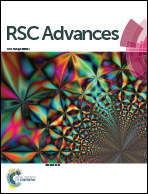Efficient Xe selective separation from Xe/Kr/N2 mixtures over a microporous CALF-20 framework†
Abstract
Capture and separation of xenon and krypton by adsorption are particularly important issues at room temperature in both industry and environmental security. Herein, hydrophobic zinc-based frameworks (CALF-20) were synthesized to separate mixtures of Xe, Kr and N2, and adsorptive properties and stability of as-prepared samples were investigated in detail. CALF-20 with the 1,2,4-triazole and oxalate as the ligand and Zn metal centers showed a surface area of 442 m2 g−1 and average pore size of 6–7 Å, and exhibited excellent stability in a high-temperature acidic solution. The single and binary adsorption datum represented that CALF-20 has a high Xe uptake of 2.45 mmol g−1 and Xe/Kr selectivity of 13.2, as well as high Xe/N2 selectivity of 62 at 298 K and 1.0 bar. The initial adsorption heat and Henry's constant of Xe on the CALF-20 were determined to be 31.7 kJ mol−1 and 21.77 mmol g−1 bar−1 by isotherms, indicating a suitable affinity for Xe capture and Xe/Kr separation. In addition, simulation results indicated that the simulated adsorption isotherms and adsorption heats are well-matched with experimental results, and the adsorption affinity from the C–H groups of 1,2,4-trizole ring for Xe is significantly stronger than that for Kr.



 Please wait while we load your content...
Please wait while we load your content...